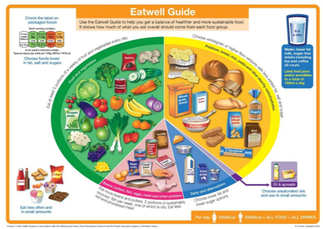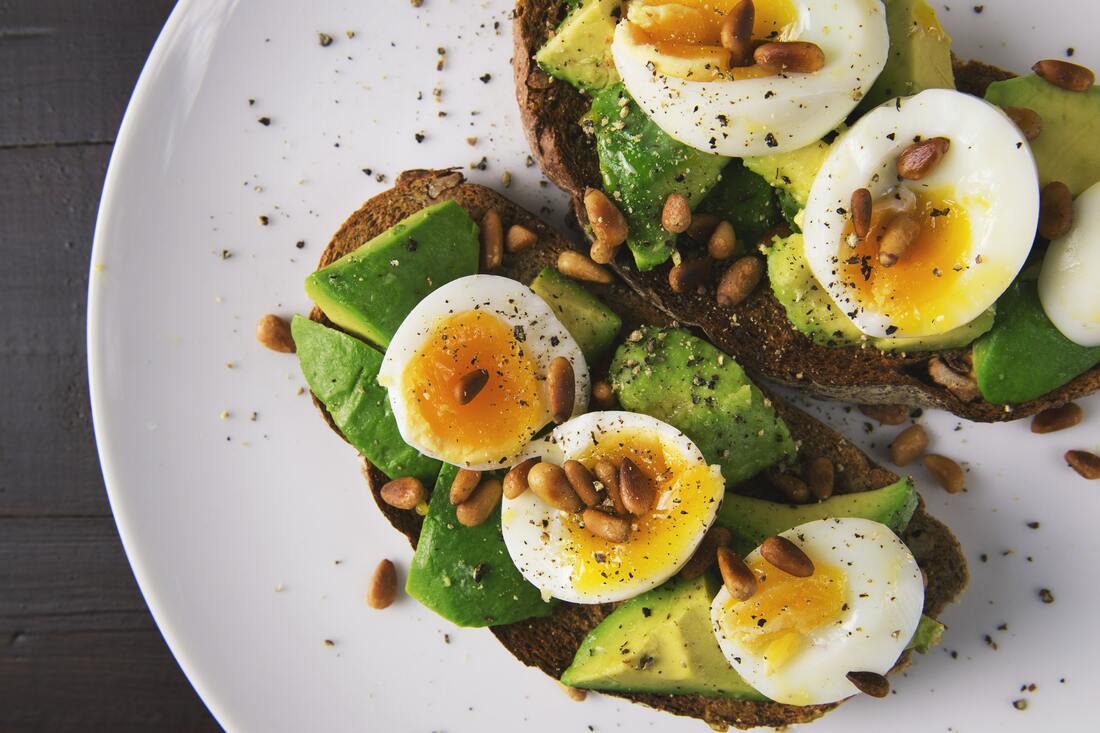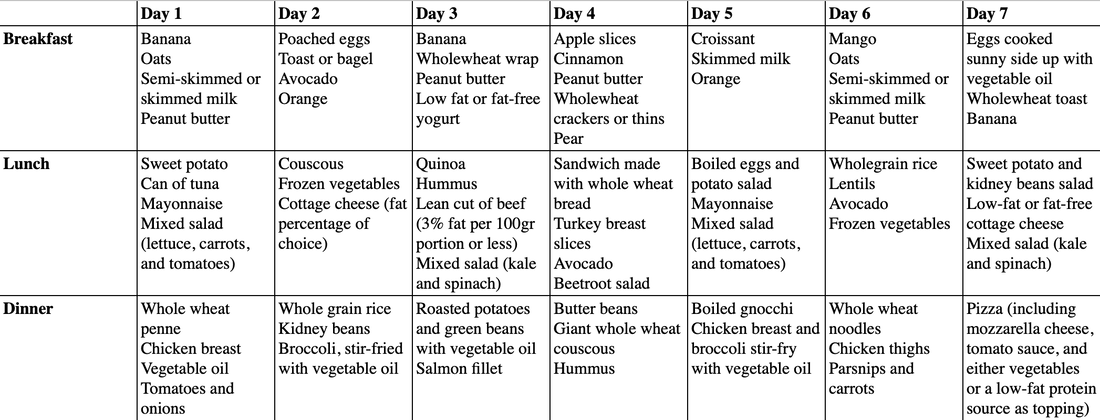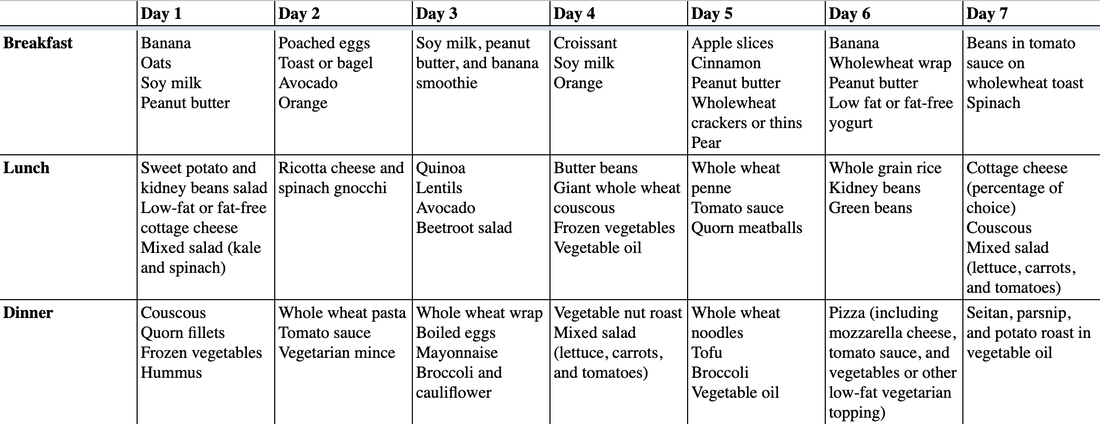The only secret to food combination is a balance of protein, carbs and fat – they all play a key role in our health. Most of us have a general idea of what protein, carbs, and fat are (and if you don’t, you should click on the links at the top!). The tricky part is the concept of a balanced meal. In today’s article, I aim to answer these questions: what does a balanced meal look like? Where do you start when you have to make one? Is there an easy way to do it, or is the art of balanced meals the privilege of those who have enough time to prepare gourmet recipes and enough money to buy organic food?  What is a “Balanced Meal”? Many countries have created visual healthy eating models to educate the general public about the core principles of a balanced diet. In the UK, Public Health England recommends the EatWell Guide (pictured), released in 2016 to replace the old EatWell Plate. In America, the USDA published MyPlate in 2011. There are other models, but, on the whole, they appear to emphasise the same factors: the importance of water intake, fruit and vegetables, whole grains, protein, and prioritising unsaturated fat over saturated fat. An easy, no-fuss way to throw together a balanced meal is to choose your ingredients in the order of importance proposed by the EatWell Guide. Here is a breakdown of this strategy:
As explained in this article, protein comes from both plant foods and animal foods. Depending on your goals and dietary lifestyle, you may want to have a bigger quota of animal protein or vice versa. To achieve balance, you could alternate between plant protein and animal protein throughout the day: you could have eggs for breakfast (animal source), kidney beans for lunch (plant source), and either tofu (plant source) or fish (animal source) for dinner. If you don’t eat meat, it’s important to combine sources of plant-based protein that contain different amounts of the eight essential amino acids. This way, if one of your sources is low in a certain amino acid and another is high in the same amino acid, by consuming them together you will still be eating complete protein overall. The table below shows some examples of plant protein combos: What About Snacks? A simplified version of the strategy outlined above works for snacks, too. Instead of choosing a food item from each category – vegetables and fruit, protein, carbs, and fat – you would only pick two categories to focus on. I would recommend combining a more satiating nutrient (either fat or protein) with a less satiating one (fruit, vegetables, or starchy carbohydrates), so that your snack keeps you going until the next meal. Moreover, if you decide to have protein as your more satiating nutrient, you could incorporate a source you have less often. For instance, if you don’t eat much dairy, you can boost your calcium intake with a yogurt and add a piece of fruit. Other examples of balanced snacks include protein bars, granola and soy milk, fruit and chocolate, carrots and cheese spread, or a classic: banana and peanut butter. How to Go About Portion Sizes? If you are committed to improving your dietary habits and your goals are related to energy balance (the relationship between energy coming in and energy going out of your body), weighing food is going to be the easiest way to hit the right portion size for you. There are also simpler methods, such as a recent portion size guide available for free download, courtesy of the British Nutrition Foundation. However, estimating portions based on hand and finger size yields less accurate results than weighing. For this reason, it could be detrimental to weight-related goals unless you already have a good understanding of how much you would need to eat in order to achieve them. For beginners, a period of weighing food could be very beneficial to develop their nutritional awareness. On the other hand, you may not be interested in calories, weight gain or fat loss, but you may want to make other healthy changes to your diet while maintaining your weight. For that purpose, the abovementioned BNF portion size guide is a useful, stress-free method to expand your knowledge of your food habits. Putting It All Together I created two sets of sample balanced meals and snacks covering seven days. One is suitable for omnivores, the other for vegetarians who eat eggs and dairy (more restrictive vegetarians and vegans can make suitable alterations). The first table follows the EatWell Guide guidelines, providing beans and pulses as alternatives to animal protein sources; at least five portions of vegetables and fruit per day; two portions of fish per week, one of which oily; and a moderate amount of red meat. The second table follows the same guidelines, minus meat and fish, and offers combinations of plant protein sources containing all essential amino acids. These are examples, not prescriptions. Feel free to “steal” and customise them as you like. You also don’t have to have all three meals and two snacks every day (for more on this topic, check out this article, where I smash a myth about the “ideal” meal frequency). If you do make modifications, replace like with like: a carb source with another carb source, a protein source with another protein source, and a fat source with another fat source. This will ensure the meals remain balanced. Omnivore Sample Meals Vegetarian Sample Meals Final Thoughts
Ultimately, healthy, balanced meals are a combination of single-ingredient food items, like a potato or an avocado. These also happen to be less processed and relatively easy to prepare (if you have access to no other kitchen equipment, you can find the microwave version of most recipes on Google). Therefore, a starting point to improve your current diet is trying to eat more fruit, vegetables, and single-ingredient food items. Don’t worry too much about variety. The tables included in this article display many different meals to give you plenty of choice, but you aren’t failing if your diet is a little more monotonous (mine definitely is!). Try to rotate between two to four items for each food group each week, so that you have a minimum of two choices and a maximum of four per food group. For example, you could have bread, noodles, rice, and quinoa as your go-to four starchy carbohydrates to spread across your weekly meals. This should provide you with all the nutrients you need without breaking the bank or forcing you to learn a lot of recipes. In Future Episodes: If you follow me on Instagram (if you don’t… why don’t you?), you may know I became a certified Nutrition and Weight Management Advisor last week. My assessment consisted in an eight-week case study, working with a client. At the end of the experience, she agreed to an interview about her experience, expectations, struggles, and results. So, if you have no idea what an advisor does, check out next week’s article! Your Turn: Do you think your meals are balanced? Give me some examples in the comments!
22 Comments
9/5/2022 07:25:50 pm
Really informative article, I had the opportunity to learn a lot, thank you. https://freecodezilla.net/wordpress-auto-spinner-articles-rewriter/
Reply
9/11/2022 09:51:26 pm
Really informative article, I had the opportunity to learn a lot, thank you. https://kurma.website/
Reply
9/12/2022 12:39:22 pm
Really informative article, I had the opportunity to learn a lot, thank you. https://odemebozdurma.com/
Reply
9/15/2022 03:00:03 am
Really informative article, I had the opportunity to learn a lot, thank you. https://bit.ly/site-kurma
Reply
9/30/2022 09:41:31 am
It's great to have this type of content. Good luck with your spirit. Thank you. https://bit.ly/site-kurma
Reply
10/4/2022 11:50:44 pm
I think this post is useful for people. It has been very useful for me. Looking forward to the next one, thank you. https://escortnova.com/escort-ilanlari/cankiri-escort/ilgaz-escort/
Reply
10/6/2022 03:11:33 am
I follow your posts closely. I can find it thanks to your reliable share. Thank you. https://escortnova.com/escort-ilanlari/balikesir-escort/sindirgi-escort/
Reply
10/6/2022 01:03:40 pm
I support your continuation of your posts. I will be happy as new posts come. Thank you. https://escortnova.com/escort-ilanlari/kutahya-escort/altintas-escort/
Reply
10/7/2022 01:07:53 pm
I think the content is at a successful level. It adds enough information. Thank you. https://escortnova.com/escort-ilanlari/nigde-escort/bor-escort/
Reply
10/8/2022 07:42:03 am
Thank you for your sharing. I must say that I am successful in your content. https://escortnova.com/escort-ilanlari/aydin-escort/bozdogan-escort/
Reply
10/8/2022 01:45:37 pm
Thoughtful and real content is shared. Thank you for these shares. https://escortnova.com/escort-ilanlari/erzurum-escort/askale-escort/
Reply
11/21/2022 06:28:34 pm
Hemen Göz At evde para kazanmaya basla: https://sites.google.com/view/evden-ek-is/
Reply
12/9/2022 06:01:08 pm
İnstagram beğeni takipçi satın al: https://takipcialdim.com/instagram-begeni-satin-al/
Reply
12/9/2022 06:01:16 pm
Düşmeyen bot takipçi satın al: https://takipcialdim.com/
Reply
12/15/2022 05:32:31 pm
takipçi satın al ve sitemizi ziyaret et: https://takipcim.com.tr/
Reply
Your comment will be posted after it is approved.
Leave a Reply. |
Nikias TomasielloWelcome to my blog. I’m an online fitness coach with a passion for bodybuilding, fantasy, and bread. Want to work with me? Check out my services!Archives
May 2024
Tags
All
|
Follow me on social media |
Get in touch |
© 2018-2023 Veronica Tomasiello, known as Nikias Tomasiello – All rights reserved







 RSS Feed
RSS Feed